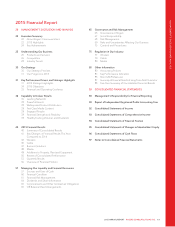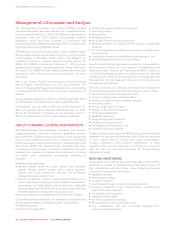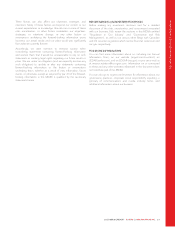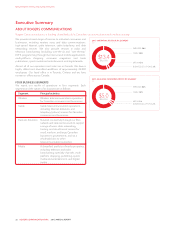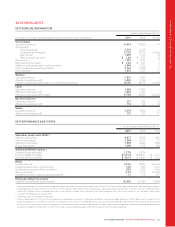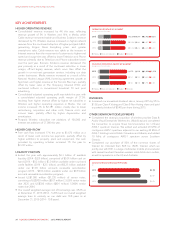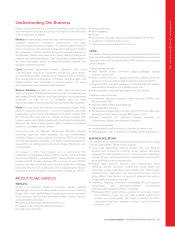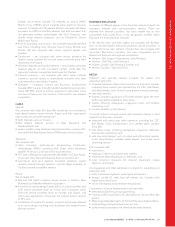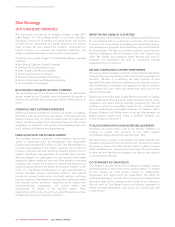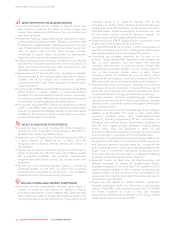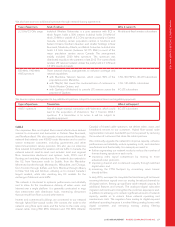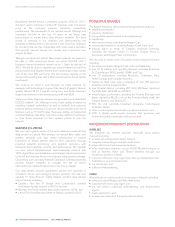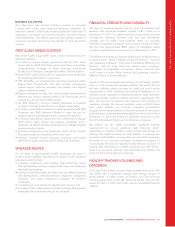Rogers 2015 Annual Report Download - page 31
Download and view the complete annual report
Please find page 31 of the 2015 Rogers annual report below. You can navigate through the pages in the report by either clicking on the pages listed below, or by using the keyword search tool below to find specific information within the annual report.
MANAGEMENT’S DISCUSSION AND ANALYSIS
WIRELESS TRENDS CABLE TRENDS
More sophisticated wireless networks and devices and the rise of
multimedia and Internet-based applications are making it easier
and faster to receive data, driving growth in wireless data services.
Wireless providers are investing in the next generation of
broadband wireless data networks, such as LTE and future 5G
technologies, to support the growing data demand.
Wireless market penetration in Canada is approximately 82% of
the population and is expected to grow at an estimated 1.4%
annually over the next five years, per Goldman Sachs’ Global
Investment Research Reports.
Effective June 3, 2015, the Canadian Radio-television and
Telecommunications Commission (CRTC) Wireless Code has
limited wireless term contracts to two years from three years, which
has resulted in a greater number of customers completing and
renewing contracts at any given time. Shorter-term contracts also
generally create lower product subsidies as there is less time for
carriers to recover those subsidies.
Subscribers are increasingly bringing their own devices or keeping
their existing devices for a longer period and therefore may not
enter into term contracts for wireless services. This may negatively
impact our subscriber churn, but may create gross addition
subscriber opportunities as a result of increased churn from other
carriers. This also may negatively impact the monthly service fees
charged to subscribers.
Wireless providers are collaborating with OTT services to offer their
customers unique, value-added benefits.
Mobilecommercecontinuestoincreaseasmoredevicesand
platforms adopt secure technology to facilitate wireless
transactions.
The Internet and social media are increasingly being used as a
substitute for traditional wireline telephone services, and
televised content is increasingly available online, on both wireline
and wireless devices. Downward Television tier migration (cord
shaving) and Television cancellation with the intent of
substitution (cord cutting) appear to be on the rise with
increased adoption of OTT services, such as Apple TV, Netflix,
and Android-based TV boxes.
Broadcast television technology continues to improve with 4K TV
broadcasts and high dynamic range (HDR) for higher resolution
andimprovedmotionvideo.
Regulatory rulings, such as the CRTC Let’s Talk TV hearing, will
result in an increase in à la carte, or “pick and pay”, TV channel
options that may negatively impact the industry.
Our digital cable and VoIP telephony services compete with
competitor IPTV deployments and non-facilities-based service
providers, respectively, which continue to increase competitive
intensity that have and may continue to negatively impact the
industry.
Cable and wireline companies are expanding their service
offerings to include faster broadband Internet. Canadian
companies, including Rogers, are beginning to offer download
speeds of 1 Gbps and Internet offerings with unlimited
bandwidth in response to the perceived “need for speed”.
Consumers are demanding ever-faster speeds for streaming
online media, playing online video games, and for their ever-
growing number of Internet-capable devices. In order to help
facilitate these speeds, companies are upgrading networks to
use fibre optic cable instead of traditional coaxial or copper core
cable. Traditional cables cannot transfer data with the speed of
fibre optics, allowing for a more engaging customer experience.
BUSINESS SOLUTIONS TRENDS MEDIA TRENDS
Companies are using fibre-based access and cloud computing to
capture and share information in more secure and accessible
environments. This, combined with the rise of multimedia and
Internet-based business applications, is driving exponential growth
in data demand.
Enterprises and all levels of government are dramatically
transforming data centre infrastructure by moving toward virtual
data storage and hosting. This is driving demand for more
advanced network functionality, robust, scalable services, and
supportive dynamic network infrastructure.
Carriers are dismantling legacy networks and investing in next
generation platforms and data centres that combine voice, data,
and video solutions onto a single distribution and access platform.
Companies are using third parties to increase security for their
data and information to address cyber threats and other
information security risks.
Devices and machines are becoming more interconnected and
there is more reliance on the Internet and other networks to
facilitate updates and track usage.
Consumer demand for digital media, mobile devices, and on-
demand content is pushing advertisers to shift spending away
from conventional TV to digital platforms.
Competition has changed: traditional media assets in Canada
are increasingly being controlled by a small number of
competitors with significant scale and financial resources, and
technology has allowed new entrants and even individuals to
become media players in their own right.
Many players have become more vertically integrated across
both traditional and emerging platforms. Both providers and
purchasers of content have made the business plan more
uncertain as the relationship between these entities has become
more complex. Global aggregators have also emerged and are
competing for both content and viewers.
Access to live sports and other premium content has become
even more important for acquiring and retaining audiences that
in turn attract advertisers and subscribers. Ownership of content
and/or long-term agreements with content owners has therefore
also become increasingly important to media companies.
2015 ANNUAL REPORT ROGERS COMMUNICATIONS INC. 29


